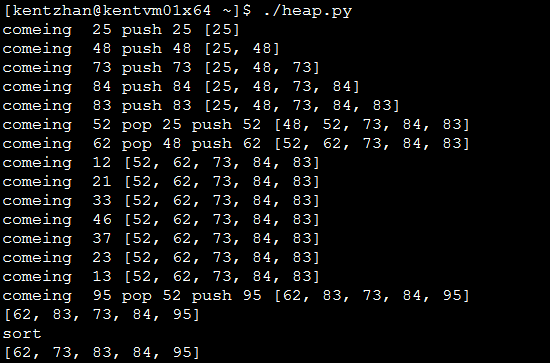heapq 模块提供了堆算法。heapq是一种子节点和父节点排序的树形数据结构。这个模块提供heap[k] <= heap[2*k+1] and heap[k] <= heap[2*k+2]。为了比较不存在的元素被人为是无限大的。heap最小的元素总是[0]。
打印 heapq 类型
?
1
2
3
4
5
6
7
8
9
10
11
12
13
14
15
16
17
18
19
20
21
22
23
24
25
26
importmath
importrandom
fromcStringIO importStringIO
defshow_tree(tree, total_width=36, fill=' '):
output=StringIO()
last_row=-1
fori, n inenumerate(tree):
ifi:
row=int(math.floor(math.log(i+1,2)))
else:
row=0
ifrow !=last_row:
output.write('\n')
columns=2**row
col_width=int(math.floor((total_width*1.0)/columns))
output.write(str(n).center(col_width, fill))
last_row=row
printoutput.getvalue()
print'-' * total_width
print
return
data=random.sample(range(1,8),7)
print'data: ', data
show_tree(data)
打印结果
?
1
2
3
4
5
6
7
data: [3, 2, 6, 5, 4, 7, 1]
3
2 6
5 4 7 1
-------------------------
heapq.heappush(heap, item)
push一个元素到heap里, 修改上面的代码
?
1
2
3
4
5
6
7
8
heap=[]
data=random.sample(range(1,8),7)
print'data: ', data
fori indata:
print'add %3d:' % i
heapq.heappush(heap, i)
show_tree(heap)
打印结果
?
1
2
3
4
5
6
7
8
9
10
11
12
13
14
15
16
17
18
19
20
21
22
23
24
25
26
27
28
29
30
31
32
data: [6, 1, 5, 4, 3, 7, 2]
add 6:
6
------------------------------------
add 1:
1
6
------------------------------------
add 5:
1
6 5
------------------------------------
add 4:
1
4 5
6
------------------------------------
add 3:
1
3 5
6 4
------------------------------------
add 7:
1
3 5
6 4 7
------------------------------------
add 2:
1
3 2
6 4 7 5
------------------------------------
根据结果可以了解,子节点的元素大于父节点元素。而兄弟节点则不会排序。
heapq.heapify(list)
将list类型转化为heap, 在线性时间内, 重新排列列表。
?
1
2
3
4
5
print'data: ', data
heapq.heapify(data)
print'data: ', data
show_tree(data)
打印结果
?
1
2
3
4
5
6
7
8
data: [2, 7, 4, 3, 6, 5, 1]
data: [1, 3, 2, 7, 6, 5, 4]
1
3 2
7 6 5 4
------------------------------------
heapq.heappop(heap)
删除并返回堆中最小的元素, 通过heapify() 和heappop()来排序。
?
1
2
3
4
5
6
7
8
9
10
11
12
data=random.sample(range(1,8),7)
print'data: ', data
heapq.heapify(data)
show_tree(data)
heap=[]
whiledata:
i=heapq.heappop(data)
print'pop %3d:' % i
show_tree(data)
heap.append(i)
print'heap: ', heap
打印结果
?
1
2
3
4
5
6
7
8
9
10
11
12
13
14
15
16
17
18
19
20
21
22
23
24
25
26
27
28
29
30
31
32
33
34
35
36
37
data: [4, 1, 3, 7, 5, 6, 2]
1
4 2
7 5 6 3
------------------------------------
pop 1:
2
4 3
7 5 6
------------------------------------
pop 2:
3
4 6
7 5
------------------------------------
pop 3:
4
5 6
7
------------------------------------
pop 4:
5
7 6
------------------------------------
pop 5:
6
7
------------------------------------
pop 6:
7
------------------------------------
pop 7:
------------------------------------
heap: [1, 2, 3, 4, 5, 6, 7]
可以看到已排好序的heap。
heapq.heapreplace(iterable, n)
删除现有元素并将其替换为一个新值。
?
1
2
3
4
5
6
7
8
9
data=random.sample(range(1,8),7)
print'data: ', data
heapq.heapify(data)
show_tree(data)
forn in[8,9,10]:
smallest=heapq.heapreplace(data, n)
print'replace %2d with %2d:' % (smallest, n)
show_tree(data)
打印结果
?
1
2
3
4
5
6
7
8
9
10
11
12
13
14
15
16
17
18
19
20
21
22
23
24
25
26
27
data: [7, 5, 4, 2, 6, 3, 1]
1
2 3
5 6 7 4
------------------------------------
replace 1 with 8:
2
5 3
8 6 7 4
------------------------------------
replace 2 with 9:
3
5 4
8 6 7 9
------------------------------------
replace 3 with 10:
4
5 7
8 6 10 9
------------------------------------
heapq.nlargest(n, iterable) 和 heapq.nsmallest(n, iterable)
返回列表中的n个最大值和最小值
?
1
2
3
4
5
6
data=range(1,6)
l=heapq.nlargest(3, data)
printl
s=heapq.nsmallest(3, data)
prints
PS:一个计算题
构建元素个数为 K=5 的最小堆代码实例:
?
1
2
3
4
5
6
7
8
9
10
11
12
13
14
15
16
17
18
19
20
21
22
23
24
25
26
27
28
29
30
31
32
importheapq
importrandom
heap=[]
heapq.heapify(heap)
fori inrange(15):
item=random.randint(10,100)
print"comeing ", item,
iflen(heap) >=5:
top_item=heap[0]
iftop_item < item:
top_item=heapq.heappop(heap)
print"pop", top_item,
heapq.heappush(heap, item)
print"push", item,
else:
heapq.heappush(heap, item)
print"push", item,
pass
printheap
pass
printheap
print"sort"
heap.sort()
printheap
结果:




